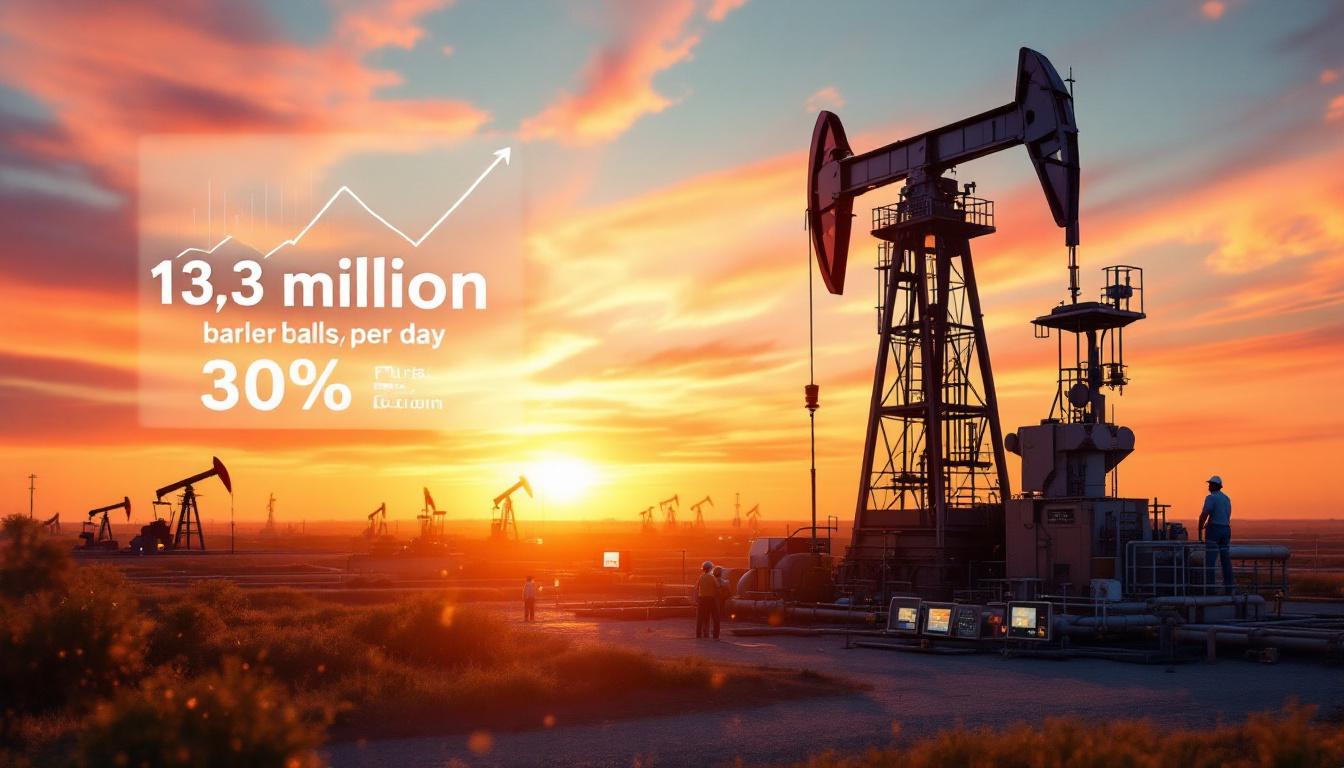US Judge to Rule by May 14 on Rio Tinto's Resolution Copper Project
The long-standing battle over one of America's largest copper deposits reaches a critical juncture as Federal Judge Steven Logan prepares to deliver a pivotal ruling by May 14, 2025. This decision will determine whether to block the controversial land transfer to mining giants Rio Tinto and BHP, potentially altering the fate of both a sacred Apache worship site and a strategically significant mineral resource.
What is the Resolution Copper Project Controversy?
At the heart of this dispute lies Oak Flat, a federally owned campground in Arizona that holds profound religious significance for the San Carlos Apache tribe. This same land sits atop an estimated 40+ billion pounds (18.1 million metric tons) of copper—a critical mineral essential for the critical minerals energy transition and technology sectors.
The proposed mining operation would eventually create a massive 2-mile wide, 1,000-foot deep crater, permanently altering the landscape and ultimately engulfing the sacred site. For Rio Tinto, which currently spends approximately $11 million monthly on project maintenance, the stakes are enormous—both financially and strategically.
"This site represents one of the most significant undeveloped copper deposits in North America," notes Dr. James Harding, mining economist at the University of Arizona. "The economic potential is substantial, but so are the cultural and religious implications."
The Legal Battle Between Native Rights and Mining Interests
The Apache Stronghold, representing tribal interests, has fought a multi-year legal battle against the land transfer, which was initiated during Trump's first term, paused by the Biden administration, and restarted in April 2025. The case centers on whether the destruction of a sacred site violates religious freedoms protected under the U.S. Constitution and the Religious Freedom Restoration Act.
Judge Logan previously ruled in favor of the land transfer in 2021, deferring to the 2014 Congressional decision that authorized the exchange—legislation passed with bipartisan support and signed by then-President Obama. The current hearing considers a temporary block while the Supreme Court deliberates whether to take the case.
"All the Apaches are asking for is a temporary hold while the Supreme Court decides whether to hear their case," argues Joseph Davis of the Becket Fund for Religious Liberty, which represents the Apache Stronghold. "The destruction of Oak Flat would permanently eliminate their ability to practice sacred ceremonies that have been conducted there for generations."
Why is the Resolution Copper Project Significant?
The Resolution Copper Project extends far beyond a local land dispute, touching on national security, economic development, and the global race for critical minerals.
Critical Minerals and Energy Transition Needs
Copper stands at the center of the clean energy transition, with copper demand trends projected to increase by more than 50% by 2040, according to International Energy Agency forecasts. An electric vehicle requires up to four times more copper than a conventional automobile, while renewable energy systems like wind and solar rely heavily on copper for transmission and generation components.
"The Resolution deposit represents a once-in-a-generation opportunity to develop a domestic source of this critical mineral," Rio Tinto stated in court filings, describing the project as "vital to securing America's energy future, infrastructure needs, and national defense."
The geopolitical implications are substantial, particularly as China continues to dominate global critical minerals supply chains. China currently controls approximately 50% of global copper refining capacity, creating strategic vulnerabilities that Resolution's development could help mitigate.
"We cannot transition to clean energy without copper, and lots of it. The question becomes where that copper will come from and under what environmental and social standards it will be produced." – Dr. Maria Santiago, Critical Minerals Policy Institute
Political Dimensions of the Project
The Resolution Copper saga spans multiple presidential administrations, highlighting how resource development decisions often transcend partisan politics. The land transfer process was initiated during Trump's first term, paused by the Biden administration while courts reviewed Apache claims, and restarted by the Trump administration in April 2025.
If Judge Logan permits the process to continue, the transfer could be completed as soon as June 16, 2025. However, even with land ownership secured, Rio Tinto would still face years of regulatory hurdles, environmental assessments, and permitting processes before mining operations could begin.
The project exemplifies the challenging balance policymakers must strike between developing domestic resources critical for economic and technological advancement while respecting indigenous rights and environmental concerns—a tension that defines many resource projects across the American West.
How Has the Legal Case Progressed?
The legal journey of the Resolution Copper Project illustrates the complex intersection of congressional authority, administrative decision-making, and judicial review in natural resource management.
Court Decisions and Congressional Actions
The current legal battle stems from a provision in the 2014 National Defense Authorization Act, which mandated the exchange of 2,422 acres of federal land containing Oak Flat for 5,344 acres owned by the mining companies. This congressional action, signed by President Obama, effectively circumvented the typical environmental review process for federal land transfers.
Multiple courts have rejected Apache Stronghold's requests to block the land transfer, with judges consistently deferring to Congress's authority to manage federal lands—even when religious considerations are involved. Notably, the U.S. Justice Department has opposed Apache requests under both the Biden and Trump administrations.
"There is no basis for this court to issue a different result," a Justice Department attorney argued during recent proceedings, emphasizing the binding nature of previous rulings and congressional authorization.
Environmental law experts point to similarities with the 1988 Supreme Court case Lyng v. Northwest Indian Cemetery Protective Association, where the Court ruled that the government could build a road through sacred Native American lands despite religious objections—a precedent that has complicated the Apache's legal strategy.
Supreme Court Considerations
The Supreme Court's handling of the case has been unusual, having delayed a decision on whether to hear the Apache Stronghold's appeal at least 13 times—a pattern that suggests significant internal deliberation among the justices.
"The repeated conferences without a decision are noteworthy," explains constitutional law professor Eleanor Wright of Georgetown University. "It could indicate that the Court recognizes the profound implications this case has for religious freedom jurisprudence, particularly as it applies to indigenous practices."
The Apache Stronghold, represented by the Becket Fund for Religious Liberty, a prominent religious freedom advocacy group, is seeking a temporary hold on land transfer proceedings while the Supreme Court makes its determination. Their argument centers on the irreparable harm that would occur if mining preparations begin before a final decision on religious rights is reached.
What Are the Stakeholders' Positions?
The Resolution Copper conflict brings together stakeholders with vastly different worldviews, priorities, and conceptions of value.
Mining Companies' Perspective
Rio Tinto (55% ownership) and BHP (45% ownership) view the Resolution Copper Project as a strategic asset in their global copper supply forecast. For these mining giants, the estimated 40+ billion pounds of copper represents a multi-decade revenue stream and positions them favorably in the growing market for clean energy minerals.
"We recognize the cultural significance of the area and have committed to working with local communities, including Native American tribes, to minimize impacts," Rio Tinto representatives stated in recent public comments. The company points to economic benefits including approximately 3,700 direct and indirect jobs at peak construction and 1,500 jobs during operations, generating an estimated $61 billion in economic impact over the project's lifetime.
The companies have proposed mitigation measures, including:
- Preservation of culturally significant artifacts
- Continued access to certain areas for religious ceremonies until mining operations make it unsafe
- Financial contributions to cultural preservation programs
- Employment opportunities and training programs for tribal members
However, critics argue these measures fail to address the fundamental issue: the permanent destruction of a sacred site whose value to the Apache cannot be measured in economic terms or mitigated through compensation.
Apache Tribe's Position
For the San Carlos Apache and other tribal members, Oak Flat—known as Chi'chil Biłdagoteel in Apache—is an irreplaceable spiritual site where deities reside and ceremonial practices dating back generations take place.
"This isn't just about land—it's about our identity, our spiritual connection to our ancestors, and our religious freedom," explained Wendsler Nosie Sr., former San Carlos Apache tribal chairman and founder of Apache Stronghold. "You cannot mitigate the destruction of a place where we connect with the Creator."
The Apache Stronghold coalition includes tribal members and allies committed to protecting Oak Flat from mining operations. Their legal arguments center on the Religious Freedom Restoration Act (RFRA), which prohibits the government from substantially burdening religious exercise without a compelling interest pursued through the least restrictive means.
According to indigenous rights advocates, the case represents a critical test of whether Native American religious practices receive the same legal protections as more mainstream faiths—especially when those practices are inseparably tied to specific landscapes.
What Happens After the Judge's Ruling?
The May 14 ruling will determine immediate next steps, but numerous scenarios remain possible for the project's ultimate fate.
Potential Outcomes and Timelines
If Judge Logan rules against the Apache Stronghold, the land transfer process could be completed as soon as June 16, 2025. However, this would represent just one milestone in a much longer journey toward actual mining operations.
Even with land ownership secured, Resolution Copper would still need to:
- Complete a comprehensive Environmental Impact Statement under the National Environmental Policy Act
- Secure dozens of state and federal permits
- Conduct detailed engineering and feasibility studies
- Obtain final investment approval from Rio Tinto and BHP boards
- Construct access infrastructure and mining facilities
This process would likely take 5-10 years before copper production could begin, with Rio Tinto indicating aims to produce copper from the site "by the end of the decade" at the earliest.
Conversely, if Judge Logan blocks the transfer pending Supreme Court review, the project faces further delays and uncertainty. Should the Supreme Court ultimately take the case, its decision could establish significant precedent regarding indigenous religious rights and federal land management that extends far beyond this single project.
"This case could potentially reshape how we think about religious freedom protections in America, particularly for indigenous communities whose spiritual practices are inextricably linked to specific places." – Legal scholar Rebecca Tsosie, University of Arizona
Broader Implications for Resource Development
The Resolution Copper dispute exemplifies the growing tension between accelerating critical minerals development—deemed essential for climate goals and technological advancement—and protecting indigenous rights and cultural heritage.
Similar conflicts are playing out across the American West, from lithium projects in Nevada to rare earth element mining in Wyoming. How courts balance these competing priorities will shape mining industry evolution for decades to come.
Environmental justice advocates point out the historical pattern of placing resource extraction burdens disproportionately on indigenous communities, while others emphasize the need for responsible domestic production to avoid outsourcing environmental impacts to countries with weaker regulations.
"If we don't produce these minerals here under strong environmental and labor standards, we'll import them from places with few protections for workers, communities, or ecosystems," notes mining policy analyst Michael Greenberg. "The question isn't whether we need copper—it's how and where we get it."
FAQ: Resolution Copper Project Legal Battle
What is at stake in the Resolution Copper legal case?
The case involves the transfer of federally owned land containing a sacred Apache site to mining companies Rio Tinto and BHP for development of one of America's largest copper deposits. At stake are religious freedom protections for indigenous communities, development of strategic mineral resources deemed critical for clean energy transition, and precedent-setting legal principles about federal land management.
When did the legal dispute begin?
The dispute stems from a 2014 Congressional decision to transfer the land, which was included as a provision in the National Defense Authorization Act and signed by President Obama. Formal legal challenges intensified after the Trump administration initiated the transfer process during his first term.
How much copper is estimated to be in the Resolution deposit?
The site contains more than 40 billion pounds (18.1 million metric tons) of copper, making it one of the largest undeveloped copper deposits in the world. At current copper prices, the resource represents hundreds of billions of dollars in potential value.
What makes the Oak Flat site significant to the Apache?
Oak Flat Campground is a sacred worship site where many Apache practice their religious ceremonies and connect with their deities. The area contains numerous culturally significant features including burial grounds, petroglyphs, medicinal plants, and sites for coming-of-age ceremonies that have been practiced for generations.
What happens if the land transfer is approved?
If approved, Resolution Copper would gain ownership of the land and proceed with permitting and development plans. The mining company development stages would eventually create a massive crater that would engulf the Oak Flat site. However, actual mining operations would require numerous additional approvals and several years of development before copper production could begin.
Disclaimer: This article contains information about an ongoing legal case with significant implications for multiple stakeholders. The situation continues to evolve, and future court decisions may alter the trajectories described. Economic projections and timelines represent estimates based on currently available information.
Ready to Catch the Next Major Mineral Discovery?
Don't miss potential investment opportunities like Resolution Copper. Discovery Alert's proprietary Discovery IQ model delivers instant notifications on significant ASX mineral discoveries, providing actionable insights before the broader market. Explore our dedicated discoveries page to understand how major mineral discoveries can lead to substantial returns.




